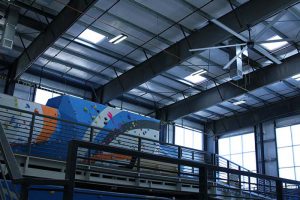Although the benefits of high volume, low speed (HVLS) fans are numerous, the installation process...
How Warehouse Ceiling Fans Increase Air Circulation & Reduce AC Costs
This is a guide to utilizing warehouse ceiling fans to increase air circulation and reduce AC costs for your facilities. As we approach summer, warehouse cooling costs can increase drastically. It’s important for both employee health and overall productivity to keep your space cool and comfortable. Many air conditioning methods can be quite ineffective, especially with high ceilings, but with the right fan for your building, YOU CAN run your cooling systems quite efficiently.
Warehouse cooling costs in summer
Cooling a large warehouse in the blistering summer heat can become very costly, especially when using conventional air conditioning methods. Many different aspects can cause your cooling costs to soar. Thankfully, there are plenty of ways that you can make your system more efficient and cost-effective. One money-saving tip is to seal off any cracks in doorways or windows. This will prevent warm air from seeping into the building. Another tip is to install curtains on any windows that receive direct sunlight. This can provide more shade and protection from the heat of the sun. Keeping up with maintenance on your cooling systems and replacing filters when needed is another way you can ensure they are working most efficiently.
How our large warehouse ceiling fans work
HVLS ceiling fans work by moving large volumes of air with expansive blades at a much slower speed than traditional fans. The slow speed allows for less stress and strain on moving parts. This means much less maintenance cost out of your pocket. The slower speed also minimizes airborne pollutants and irritants like dust. Our industrial ceiling fans have a powerful motor to move a very high volume of air. They will increase airflow throughout your entire warehouse. Another great benefit of warehouse ceiling fans is that they are very quiet. In a busy warehouse environment, "quiet" can be important in maintaining communication between employees.
Floor standing fans vs large ceiling fans
While floor fans seem like an ideal solution due to the low cost and ease of installation, ceiling fans are superior. They move large amounts of air in large industrial buildings or warehouses. The sheer amount of air that large ceiling fans move makes them the ideal option for commercial and industrial spaces. Additionally, having fans and wires off the ground frees up floor space. Plus, there are far fewer tripping hazards.
The functionality of HVLS ceiling fans is another reason that they are better for cooling (and heating) big areas. In the summer months, these ceiling fans can be operated in the counterclockwise direction to push air downward. This will create a cool breeze. In the colder winter months, the direction of the fans can be changed to clockwise. This will pull warm air downward which naturally rises to the ceiling and recirculates to provide a warm draft. This can greatly decrease your heating costs. For air circulation purposes and overall cooling of your warehouse, we recommend opting to install ceiling fans in your facility. However, for extra close-range cooling, free-standing may be an option. This may be especially true during those extra hot, mid-summer months.
Money savings from using fans with or without AC
Often, we assume that using AC will quickly and efficiently decrease the temperature on its own. However, this is a common misconception, especially for larger spaces. To use your AC most effectively in large buildings or facilities, it's best to use it in tandem with large ceiling fans. Because AC cools the air by taking outside air in and pushing out cooler air it hardly does anything at all to help with air circulation. By installing a large ceiling fan, the cool air produced by your AC will be magnified and can feel up to 8 degrees cooler than the temperature set on its thermostat.
Improved air circulation (air quality)
Not only does increasing your warehouse air circulation help to reduce indoor temperatures and keep the environment cool and dry, but it can also dilute indoor airborne contaminants and can significantly increase the air quality in your warehouse. Along with the right air filtration, improving circulation will help to minimize any pollutants or irritants present in the air which makes for a much safer work environment for employees.
Improved employee productivity when cool and dry
As previously mentioned, with proper air circulation your warehouse can stay both cool and dry, fostering a better environment for employee health and productivity. The Occupational Safety & Health Administration (OSHA) has standards set that state that to provide a proper work environment for employees it is recommended employers maintain workplace temperatures between the range of 68-76 degrees Fahrenheit. By ensuring cooler temperatures your employees will be much happier and more productive in their work. Additionally, proper circulation and airflow maximize the human body's natural cooling method, evaporation (sweating), and keeps them from overheating which will maintain productivity.
Choosing the right fan for your space
At this point, you probably know that you want a fan to keep your warehouse cool and dry, but maybe you’re not so sure about how to choose the right HVLS ceiling fan. Choosing the best fit fan for your space will help you efficiently move massive amounts of air quietly. With our quick 5 questions quiz, you can find the perfect fan for your space in just a few clicks! Visit our HVLS Fan Selection Tool to find your perfect big fan!
Now that you know how warehouse ceiling fans can increase your air circulation and reduce AC cooling costs, especially during the summertime, you can find the perfect fan for your warehouse or commercial space. For more information on MacroAir and our big fans please visit our website, and to reach out with any questions go to our contact us page.


